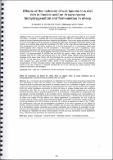Por favor, use este identificador para citar o enlazar a este item:
http://hdl.handle.net/10261/117016COMPARTIR / EXPORTAR:
 SHARE
BASE SHARE
BASE
|
|
| Visualizar otros formatos: MARC | Dublin Core | RDF | ORE | MODS | METS | DIDL | DATACITE | |

| Título: | Effects of the inclusion of oak tannins in a diet rich in linoleic acid on in vitro rumen biohydrogenation and fermentation in sheep |
Otros títulos: | Effets de l'inclusion de tanins de chêne dans un régime riche en acide linoléique sur la biohydrogénation et la fermentation ruminale chez les ovins | Autor: | Carreño Yugueros, David CSIC ORCID; Hervás, Gonzalo CSIC ORCID ; Toral, Pablo G. CSIC ORCID ; Belenguer, Álvaro CSIC ORCID ; Frutos, Pilar CSIC ORCID | Palabras clave: | Ewe Fatty acid Oak tannins Rumen microbiota Ruminal fermentation Brebis Acide gras Tanins de chêne Microbiote ruminale Fermentation ruminale |
Fecha de publicación: | jun-2015 | Editor: | Centre international de hautes études agronomiques méditerranéennes Centre international de recherche en agronomie pour le développement |
Citación: | FAO-CIHEAM Network on Sheep and Goats. Joint Seminar of the Sub-Network on Production Systems and Sub-Network on Nutrition : 105 (2015) | Resumen: | There is a void of knowledge about which of the many types of tannins might be more specific and useful, in practice, to interfere with rumen biohydrogenation (BH) and modulate the fatty acid (FA) profile of ruminant derived products without impairing diet utilization. Two in vitro assays with batch cultures of rumen microorganisms were conducted to analyze the effect of an oenological commercial extract of oak tannins, at a practical dose under farm conditions (2% DM), on the rumen BH and fermentation of a diet also supplemented with 2% DM of sunflower oil. In the first experiment (12 h incubations), freeze-dried ruminal digesta were analyzed for FA composition. In the second one (24 h incubations), rumen fermentation parameters and bacterial community were examined. The addition of 2% DM of the oak tannin extract proved (P<0.01) to be able to slightly reduce the concentration of 18:0 (-5.2%) and increase those of 18:2n-6, n-3 polyunsaturated FA (PUFA) and n-6 PUFA (by approx. +64%), while tended (P<0.10) to decrease trans-10 18:1 (-9%) and enhance trans-11 18:1 (+14%). These changes were accompanied by increases in the mean value of odd- and branched-chain FA, as well as in some keto-FA concentrations (P<0.05). On the other hand, it had no significant effects on the rumen fermentation characteristics that were analyzed (e.g., gas production kinetic, extent of OM degradation, pH, or ammonia and VFA concentrations; P>0.10). Although positive, when explored at practical doses in terms of animal feeding, results on the use of tannins to modulate microbial BH are not as promising as initially expected. More research in this field is still necessary. | Descripción: | 1 página.-- Trabajo presentado al FAO-CIHEAM Network on Sheep and Goats. Joint Seminar of the Sub-Network on Production Systems and Sub-Network on Nutrition: The value chain in Mediterranean sheep and goats. Industry organisation, marketing strategies, feeding and production systems, p. 105 (S3.4-P14). 16-18 de junio de 2015. Montpellier (Francia) | Versión del editor: | http://www.iamz.ciheam.org/montpellier2015/Programme.html | URI: | http://hdl.handle.net/10261/117016 |
| Aparece en las colecciones: | (IGM) Comunicaciones congresos |
Ficheros en este ítem:
| Fichero | Descripción | Tamaño | Formato | |
|---|---|---|---|---|
| Carreno et al_2015_FAO-CIHEAM.pdf | 429,19 kB | Adobe PDF |  Visualizar/Abrir |
CORE Recommender
Page view(s)
300
checked on 24-abr-2024
Download(s)
133
checked on 24-abr-2024
Google ScholarTM
Check
NOTA: Los ítems de Digital.CSIC están protegidos por copyright, con todos los derechos reservados, a menos que se indique lo contrario.
